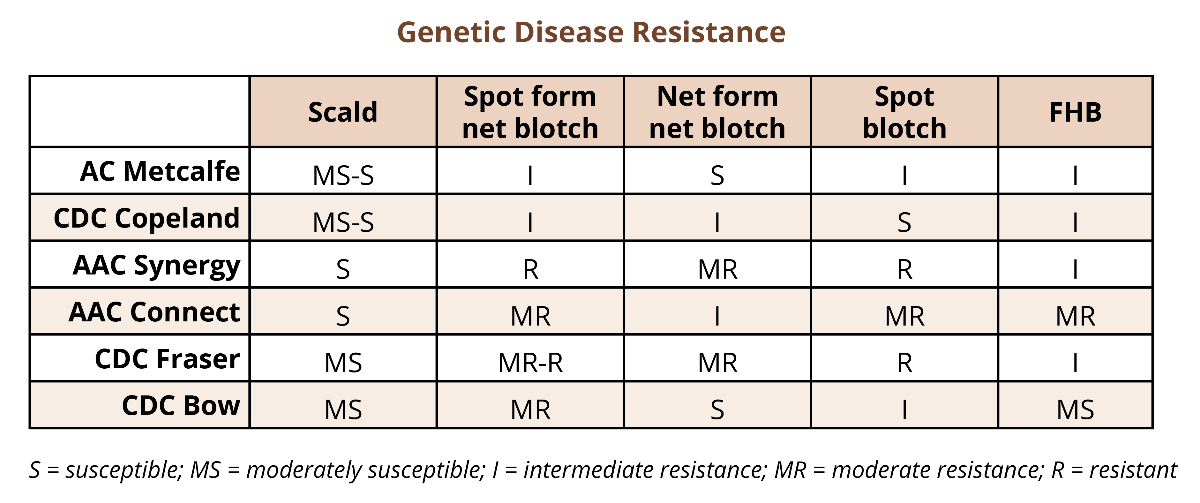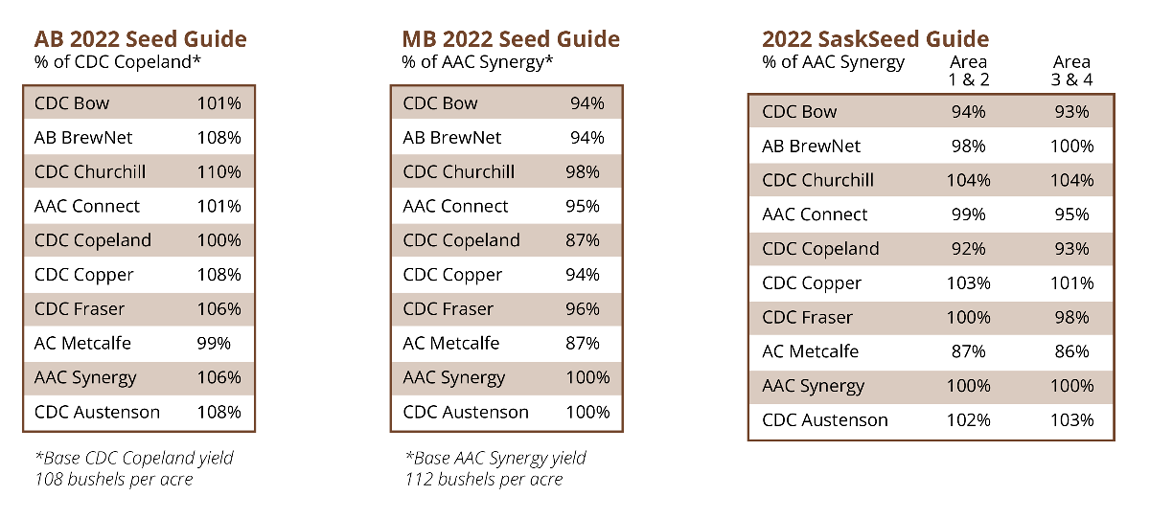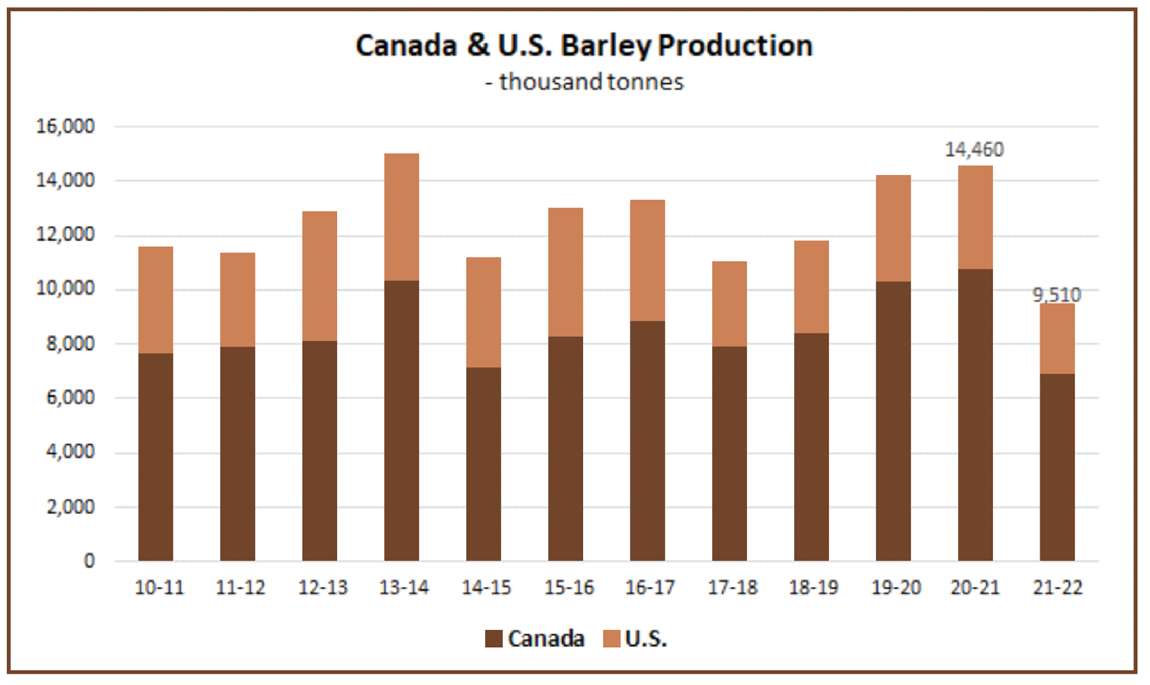Why malting barley may be a good crop to grow in 2022
March 31, 2022
New malting barley varieties offer improved agronomics and disease resistance and are gaining
traction in the marketplace. In addition to established varieties, new ones like AAC Connect and
CDC Fraser are gaining commercial acceptance by Canadian and international maltsters and brewers. And with historically tight supplies, demand for Canadian malting barley is expected to be strong
in the 2022-23 marketing season.
This bulletin provides some perspectives for producers who are considering barley in their rotation in the
2022 growing season:
- Why malting barley may be a good crop to grow in 2022
- Malting barley seeding and production recommendations
- Which malting barley variety to choose
- Profiles: AAC Connect and CDC Fraser
WHY MALTING BARLEY MAY BE A GOOD CROP TO GROW IN 2022
New malting barley varieties have improved agronomics and disease resistance
- New malting barley varieties have seen considerable improvements in agronomics in recent years with better yields, lodging and disease resistance.
- With shorter and stronger straw, new malting barley varieties are less likely to lodge. These new varieties were bred to have moderate protein content, and as a result producers may be able to push them with nitrogen applications to maximize yield without developing excessive protein levels. Maltsters and brewers prefer protein content between 10-12.5%, however the industry will often accept upwards of 13.5%.
- New malting varieties have improved disease resistance compared with older varieties for leaf diseases including spot form net blotch and spot blotch. For areas where fusarium head blight can be an issue, AAC Connect has moderate genetic resistance against FHB which may result in reduced DON accumulation when combined with other management practices, including a fungicide application.

The tables below provide yield comparisons of the malting varieties contained on the CMBTC’s recommended list from the provincial seed guides (note that CDC Austenson, a feed variety, is included for comparison purposes). Farmers should check their provincial seed guides for more information on new varieties.

Premium for malting barley; Broader market opportunities
- If a producer has already decided to grow barley, they should consider a malt variety given good premiums and greater marketplace opportunities.
- The premium for malting barley over feed has historically bounced around the $1.00 per bushel mark. Assuming the same yield, on a quarter section of land at 75 bushels an acre, that’s an additional $12,000 of revenue with only a $1 premium. However, with the current short supply of malting barley this year, premiums offered by malting and grain companies for 2022 crop have been higher than average.
Currently contract opportunities are available for producers to lock in new crop malting barley prices around $8.00 per bushel or higher depending on the region.
- Producers will also have access to more marketplaces with a malt barley variety. Typically, Canada’s malting and grain companies select 2.0-3.0 million tonnes of malting barley annually. By choosing a malt variety, producers have access to both malting and feed markets, mitigating marketing and price risk.
- With very high input prices today, barley may be an especially attractive option economically in 2022. Producers can use their provincial crop calculators to estimate returns (see links below).
Alberta Crop Calculator
Manitoba Crop Calculator
Saskatchewan Crop Calculator
Strong Demand prospects for barley in 2022-23
- Production of barley in Canada and the U.S. in 2021 totaled 9.5 million tonnes compared with 14.5 million tonnes in 2020, a drop of 34% or 5 million tonnes. With carry-in stocks at the end of 2020-21 already at historically low levels, North American barley supplies will be all but depleted by harvest 2022, which will help support demand and prices for both malting and feed barley in the 2022-23 marketing season.

- While the feed sector can substitute other crops like corn, the malting industry requires malt barley varieties that have specific processing characteristics such as sufficient enzymes to modify starches into sugars. Typically, North American malting barley buyers purchase 5.0-5.5 million tonnes of selectable malting barley each year, around 20% of global use.
- The drought followed by rains at harvest in the summer of 2021 cut the supply of selectable malting barley by some 2 million tonnes, contributing to historically tight supplies and record prices for malt barley, particularly in North America but also globally. With 2022-23 Canadian malting barley carry-in stocks forecast at virtually nil, demand for Canadian malting barley has the potential to remain strong through the 2022-23 marketing season.
CHOOSING WHICH MALT BARLEY VARIETY TO GROW
- In addition to established varieties such as CDC Copeland and AAC Synergy, Canada has a suite of newer malting barley varieties including AAC Connect, CDC Fraser, CDC Bow, CDC Copper, CDC Churchill and AB BrewNet with strong agronomy and disease packages.
- The new varieties have been developed to meet end-use malting and brewing quality requirements with moderate protein content, high extract levels and plump kernels.
- AAC Connect and CDC Fraser are two of Canada’s promising new malting barley varieties that are gaining traction in the domestic and global malting and brewing industries. Both varieties are now accepted by many maltsters and brewers both domestically and in major international markets such as the United States and China. In 2021 the first cargoes of these two varieties were sold to China.
- Farmers are encouraged to consult their local maltster, grain company and/or seed supplier when deciding which malting barley to grow. Certain varieties tend to grow better in particular environments, and each malting and grain company has their preferred varieties for their customers.
- When growing a new variety, it is recommended that producers have a contract. They should talk to their local malting barley buyer about contracting programs, and at the same time inquire about any agronomic information in relation to their growing area.
See profiles of AAC Connect and CDC Fraser below.
MALTING BARLEY SEEDING & PRODUCTION RECOMMENDATIONS
Timing, Seeding Rates, Weed & Disease Management
- Early seeded barley tends to have a yield and quality advantage on the Prairies because the crop can capitalize on early spring moisture and avoid the risk of frost, cool and wet weather at the end of summer. Early seeded crops also tend to increase the likelihood of producing plump and uniform kernels.
- Seeding at 300 live seeds/m2 (28 seeds/ft2) optimizes yield and quality including improved kernel uniformity.
- Timing of harvest is very important with malting barley. Barley should be harvested at maturity as soon as possible – starting as early as 18% grain moisture content to preserve quality. Delays can rapidly impact quality due in particular to moisture. Late harvested barley tends to be less bright, have greater microbial load, and is more likely to have started the germination process and therefore have lower vigour (i.e. germination energy).
- Malting barley may require some additional steps and costs in terms production, such as fungicide spraying for FHB management, as well as harvest and storage considerations to ensure quality for selection, although the overall ROI should be higher with premiums for malt.
Certified or Farm Saved Seed; Varietal Purity
- The drought conditions in 2021 affected both commercial and pedigreed seed crops. Certified seed availability will vary by geography so farmers should speak to their local seed suppliers early. To find seed, producers can consult provincial seed guides, check the CSGA seed locator link or go directly to a seed company’s web site.
- Malting barley buyers recommend that producers use certified seed to help guarantee quality and purity, and to increase their chances of malt selection. However, with certified seed potentially in short supply in some areas, and prices at historically high levels, producers may choose to use their own farm grown seed.
- Regardless of the seed source, it is very important for producers to knowseed germination, thousand kernel weight and disease analysis,from an accredited lab to ensure seed is not diseased and to calculate appropriate seeding rates. Testing for varietal purity may also be prudent (see below).
- Most seed sellers will test for a thousand kernel weight and disease, so be sure to ask. It is also important to note that it is illegal for producers to sell or trade varieties protected with Plant Breeders Rights (PBRs). There are significant fines associated with selling PBR protected common seed for planting.
- End-users require a minimum 95% varietal purity, a producer risks not being selected if they do not meet this threshold. If a producer is concerned, they can have their barley tested for varietal purity. The industry recommends a 92 count seed test (as opposed to a 16 count). Producers can have their seed tested for purity by SGS for a cost of approximately $250 depending on the test.
Soil Testing for Soil Nutrient Levels & Herbicide Residues
- Producers should have their soils tested in order to optimize nitrogen, phosphorus and potassium fertility. The following is a helpful guide from Alberta Agriculture regarding soil testing. Producers can also find on-line fertilizer rate calculators like this one from Manitoba Agriculture.
- Depending on the amount of rainfall received in 2021, fields may have seen reduced fertilizer uptake resulting in higher-than-average residual nutrients such as nitrogen and phosphorus in soils. It is therefore recommended that producers have their soil tested to ensure accurate application rates and increase potential for malt acceptance.
- Herbicide residues may be higher than normal after last summer’s drought. Barley may be more tolerant than other crops for which residual herbicide carry over is a concern. Be sure to consult with your chemical supplier to assess herbicide carryover risk to barley.
Crop Protection Products
- Farmers should refer to the Keep it Clean campaign regarding acceptable crop protection products for malting barley and feed barley. Pre-harvest desiccants and glyphosate are not accepted by the malting industry. Newly registered plant growth regulators in Canada may be accepted by some end-users, but farmers should check with their grain buyer before using these products.

Farmer Testimonials:
“AAC Connect two row malting barley has the disease resistance and straw strength we look for to preserve malt quality. It’s the next level compared to the older varieties”
Gordon Moellenbeck – Englefeld, Saskatchewan
“We grew CDC Fraser in 2020 and had great results. With 105 bpa and absolutely zero lodging, we felt this next-generation variety was perfect to push fertility searching for maximum yields.”
Matt Enns – Rosthern, Saskatchewan
“In the 2020 growing season, we grew AAC Connect under irrigation. What impressed us was the great yield (125 bu/ac), low lodging and no disease. I believe that the potential is there to get an even greater yield with the tweaking of our fertility package.”
Dave Bishop – Barons, Alberta
PREPARING FOR 2022 SEEDING, THE CMBTC RECOMMENDS THAT PRODUCERS:
- Choose a malting barley variety to enable marketing opportunities for both the malting/brewing or feed sectors;
- Talk to their local maltster, grain buyer, seed grower, or the CMBTC, to discuss which varieties are most suitable to grow in their region;
- For newer malt varieties, secure a contract with a malting or grain company buyer;
- If using farm-saved seed, check seed quality at an accredited lab;
- Conduct soil tests for residual nutrient availability;
- Assess risk of residual herbicide carryover and choose low risk crop rotations, which may include barley.
Sources of Information
To find the most up-to-date information for each variety, refer to your province’s seed guide to find data and seed distributors. Variety selection should consider yield, agronomic and disease indicators that align with farm-specific needs.
See also the CMBTC’s recommended list for the list of barley varieties that have the greatest potential to be selected for malting.
Follow us at the CMBTC & MaltAcademy twitter feed @canadianbarley
Additional information on barley production and trade is available through the CMBTC website’s Member’s Portal. Contact pwatts@cmbtc.com for your password.
The CMBTC does not offer advice or recommendations with respect to production or marketing decisions to the barley industry, and this information should not be construed as such.












